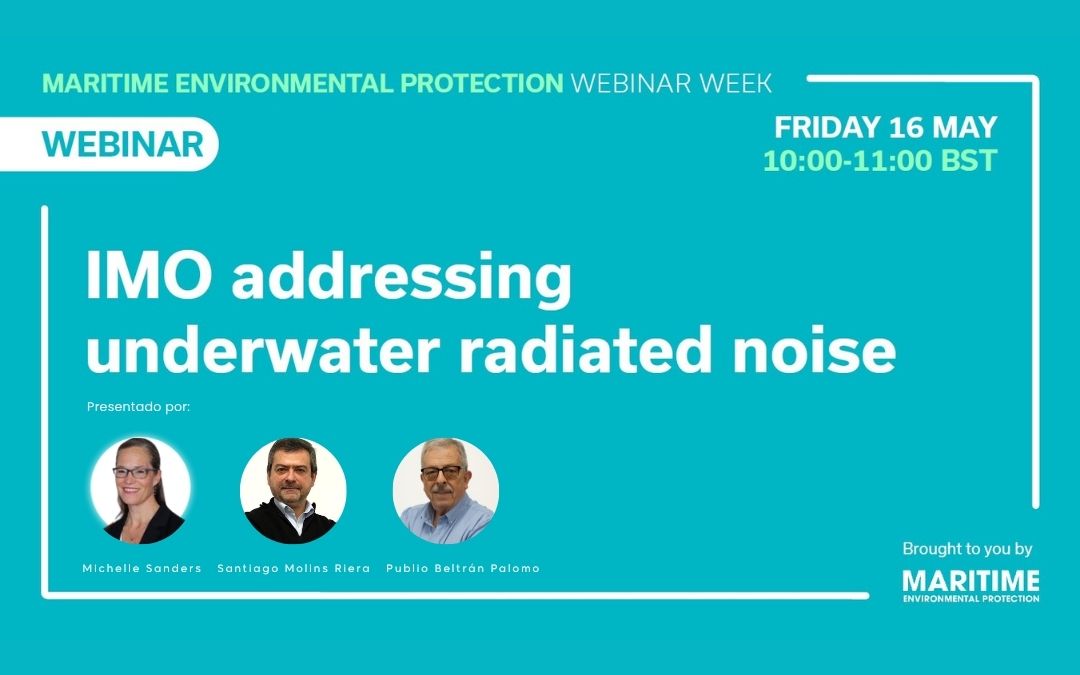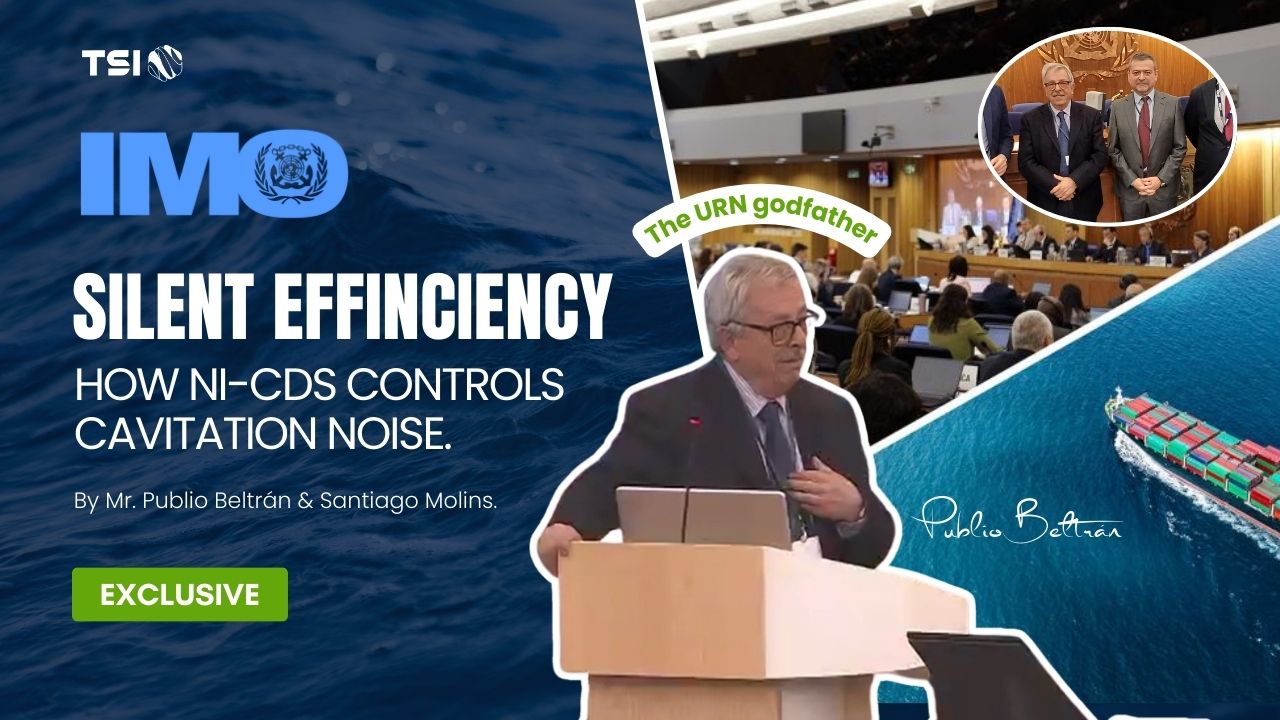Continuing our commitment to outreach and the development of sustainable solutions in the maritime sector, Técnicas y Servicios de Ingeniería (TSI) was invited to participate in the international webinar IMO Addressing Underwater Radiated Noise, organised by Riviera Maritime Media on 16 May. This invitation followed our intervention at the Marine Environment Protection Committee (MEPC 83) of the International Maritime Organization (IMO), held in London in April 2025.
Técnicas y Servicios de Ingeniería (TSI) is a Spanish company specialised in the design, development and implementation of high-level technological solutions for the maritime sector. With over 45 years of experience, TSI is actively involved in projects related to acoustic sustainability, improvement of propulsive efficiency and innovation in onboard systems. These are all major challenges!
The importance of bringing technical innovation to international forums
During the webinar, Publio Beltrán, founder and Managing Director of TSI, together with Santiago Molins, Head of R&D, addressed the challenge of Underwater Radiated Noise (URN) from a practical technical perspective, highlighting the role of non-intrusive technologies in reducing ships’ acoustic impact.
A central part of our presentation was the introduction of the Ni-CDS system (No-Intrusive Cavitation Detection System), TSI’s proprietary solution that allows real-time detection and management of cavitation — one of the main sources of ship-generated underwater noise — without modifying the vessel’s structure or interfering with the propulsion system. This system is an effective, low-investment tool, easy and quick to install — in short, cost-effective and particularly suitable for existing ship fleets seeking to improve their acoustic signature in line with IMO recommendations, without requiring major modifications.
Want to learn more about Ni-CDS? Discover how it works and the advantages it offers in our dedicated section
👉 Take a look at the IMO Conference!
At the heart of the debate: guidelines, technology, and practical application
The session allowed for a deep dive into the recently updated IMO guidelines (MEPC.1/Circ.906), which revise the framework for reducing underwater radiated noise from commercial shipping. These recommendations emphasise the need to advance both the design of new vessels and the acoustic management of existing fleets, aiming for a balance between energy efficiency, emission reduction and acoustic sustainability.
TSI and its commitment to innovation
At TSI, we have spent over four decades dedicated to research, development, and technological innovation (R&D&I) in the fields of vibration, structural noise, and acoustic sustainability in maritime transport. Our participation in leading European projects is testament to this commitment.
🔬 LOWNOISER
The Lownoiser Project (Lowering Underwater Noise Radiation from Waterborne Transport), funded with €6.3 million by the Horizon Europe programme, is a pioneering innovation initiative aimed at reducing underwater noise pollution caused by vessels. Led by Maritime CleanTech, the consortium brings together 16 European partners, including Técnicas y Servicios de Ingeniería (TSI), to develop disruptive technologies and drive structural change in the maritime industry.
Underwater radiated noise (URN) poses a silent threat to marine life. It interferes with vital functions such as communication, orientation, and reproduction in species such as cetaceans, fish, and invertebrates. LOWNOISER offers a transformative framework to tackle this environmental challenge through innovation, collaboration, and sustainability.
The project seeks not only to develop advanced acoustic mitigation technologies but also to produce technical guidelines that can be incorporated into future international regulations. Among the solutions to be implemented and validated in five full-scale demonstrators (including HX’s Roald Amundsen and Ibaizabal’s Montesperanza) are:
-
Onboard acoustic control systems to monitor and adjust emissions in real time.
-
Air lubrication systems (ALS) to reduce drag and insulate hull noise.
-
Silent components (gears, engine mounts) to minimise structural vibrations.
-
Distributed Acoustic Sensing (DAS) using fibre optics for passive noise monitoring in maritime zones.
TSI’s contribution: sensor technology, analysis, and estimation of URN emissions. As an international reference in underwater noise measurement, TSI is leading the development of an innovative onboard URN estimation system that will enable real-time acoustic emission assessments using onboard sensors, avoiding the need for costly open-sea trials.
🌍 SATURN
The SATURN Project (Solutions At Underwater Radiated Noise), part of the European H2020 programme, is a strategic alliance of 20 entities from 9 European countries. This multidisciplinary consortium combines expertise in marine biology, naval architecture and engineering to address one of maritime transport’s major environmental challenges: underwater radiated noise (URN).
SATURN’s goal is clear: to mitigate the impact of ship-generated underwater noise, thus protecting marine life and promoting more environmentally respectful navigation. The project is structured around five key work areas: standardisation of measurements, analysis of impact on marine fauna, evaluation of technical solutions, outreach and awareness, and regulatory development.
At TSI, we play a key role in SATURN, contributing over a decade of international experience in European URN-related projects (SILENV, BESST, AQUO). We lead the planning and execution of URN measurement campaigns in both deep and shallow waters, using international standards and innovative methodologies.
Our main contributions include:
-
URN trials on the oceanographic vessel Ángeles Alvariño (IEO) in Canary Islands waters.
-
Onboard noise and vibration measurements.
-
Evaluation of cost-effective methodologies to characterise URN with onboard sensors.
-
Uncertainty analysis in acoustic measurements in collaboration with key players such as JASCO, TNO, and Bureau Veritas.
-
Active participation in developing the upcoming international ISO 17208-3 standard for URN in shallow waters.
SATURN not only consolidates TSI’s position as a benchmark in acoustic sustainability but also reinforces the vision that has guided our work for over 45 years: transforming technical knowledge into real solutions for a healthier ocean.
A shared vision: technology in service of the marine environment
TSI’s participation in forums like this reinforces our belief that engineering plays a fundamental role in transitioning to a more sustainable transport model. Sharing technical knowledge, helping to train new talent, and providing real-world tools are all part of our mission as a company committed to responsible innovation.
The recognition of our Managing Director, Publio Beltrán, by Canada’s international delegate Michelle Sanders — who described him as “the godfather of underwater noise” — sums up, with humour and respect, more than 40 years of dedication to the analysis, control, and mitigation of noise and vibrations in the maritime sector. An anecdote that, without doubt, strengthens our commitment to continue working for a quieter sea.
📽️ You can watch the full recording 👉 Registration and webinar on Riviera’s official website
Check out the Conference at IMO!



